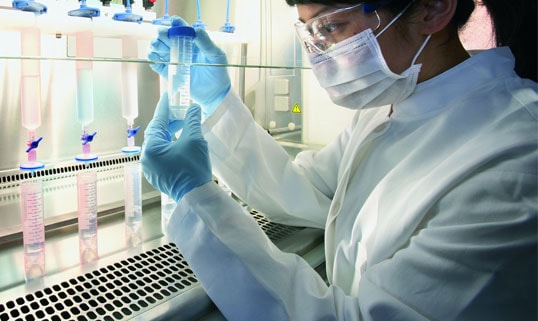CT26.WT-mNIS (monoclonal)
- Frozen / Standard (CL119-STAN) $ 2,500
Species: Mouse
Cell type: Colorectal Cancer
Transgenes: Murine sodium iodide symporter (mNIS)
Media: DMEM, 10% FBS, 1% Pen/Strep
Description: This is a monoclonal population derived from the murine colorectal carcinoma CT26.WT cell line (ATCC® CRL-2638™). Parental CT26.WT cells were transduced with LV-mNIS (Imanis #LV008) encoding the murine sodium iodide symporter (mNIS) cDNA under the spleen focus-forming virus (SFFV) promoter. A monoclonal population was isolated following two rounds of selection in a methylcellulose-based semi-solid medium.
The lentiviral vector used is a self-inactivating (SIN) vector in which the viral enhancer and promoter has been deleted. Transcription inactivation of the LTR in the SIN provirus increases biosafety by preventing mobilization by replication competent viruses and enables regulated expression of the genes from the internal promoters without cis-acting effects of the LTR (Miyoshi et al., J Virol. 1998).
Mycoplasma Testing: The CT26.WT-mNIS cell line has been tested for mycoplasma contamination and is certified mycoplasma free.
Cell Line Authentication: In light of studies suggesting that 18-36% of cell lines utilized in biomedical research are contaminated or completely misidentified, several funding organizations, including NIH, as well as major publishers, including those affiliated with the American Associate for Cancer Research (AACR), require cell lines used in research to be authenticated prior to publication. The parental CT26.WT cell line used to generate CT26.WT-mNIS was authenticated and certified free of interspecies cross contamination by STR profiling with 27 STR loci. Documentation is available upon request.
Recommended uses:
CT26.WT-mNIS cells are suitable for in vitro and in vivo experimentation.
CT26.WT cells form tumors and pulmonary metastases post implantation into syngeneic BALB/c mice. The mNIS transgene facilitates in vivo high-resolution, 3D PET/SPECT imaging of implanted cells.
The mNIS protein in not immunogenic in mice. Therefore, these cells can be used for longitudinal imaging studies in both immunocompromised mice and immunocompetent BALB/c mice.
Morphology: Low- and high-density cell morphology (200x)

NIS Function Assay (Iodine Uptake): Cells were incubated with 125I for 1h in the presence or absence of KClO4, an inhibitor of iodine uptake. Radioiodine concentrated within the cells was measured with a gamma counter.

References on NIS imaging:
1. Fruthwirth et al. A whole body dual modality radionuclide optical strategy for preclinical imaging of metastasis and heterogeneous treatment responses in different. microenvironments. J. Nucl. Med 2014. 55(4): 686-94.
2. Penheiter et al. The sodium iodide symporter (NIS) as an imaging reporter for gene, viral and cell-based therapies. Curr Gene Ther. 2012, 12(1):33-47.

